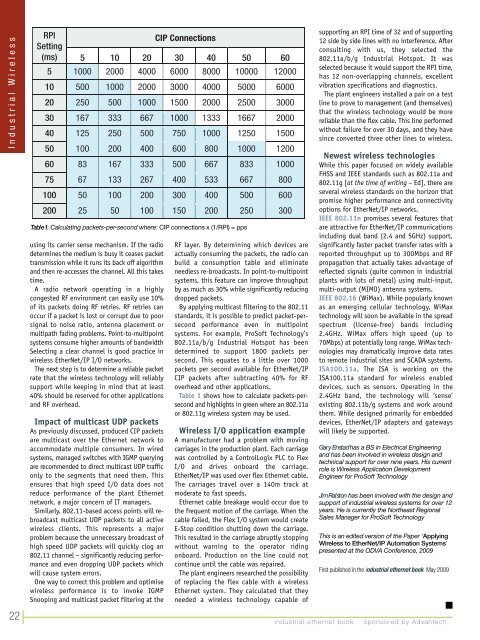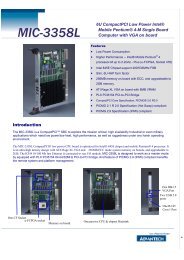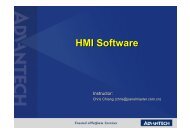industrial wireless book special edition - Networking ...
industrial wireless book special edition - Networking ...
industrial wireless book special edition - Networking ...
Create successful ePaper yourself
Turn your PDF publications into a flip-book with our unique Google optimized e-Paper software.
I n d u s t r i a l W i r e l e s s<br />
22<br />
RPI<br />
Setting<br />
CIP Connections<br />
(ms) 5 10 20 30 40 50 60<br />
5 1000 2000 4000 6000 8000 10000 12000<br />
10 500 1000 2000 3000 4000 5000 6000<br />
20 250 500 1000 1500 2000 2500 3000<br />
30 167 333 667 1000 1333 1667 2000<br />
40 125 250 500 750 1000 1250 1500<br />
50 100 200 400 600 800 1000 1200<br />
60 83 167 333 500 667 833 1000<br />
75 67 133 267 400 533 667 800<br />
100 50 100 200 300 400 500 600<br />
200 25 50 100 150 200 250 300<br />
Table 1. Calculating packets-per-second where: CIP connections x (1/RPI) = pps<br />
using its carrier sense mechanism. If the radio<br />
determines the medium is busy it ceases packet<br />
transmission while it runs its back off algorithm<br />
and then re-accesses the channel. All this takes<br />
time.<br />
A radio network operating in a highly<br />
congested RF environment can easily use 10%<br />
of its packets doing RF retries. RF retries can<br />
occur if a packet is lost or corrupt due to poor<br />
signal to noise ratio, antenna placement or<br />
multipath fading problems. Point-to-multipoint<br />
systems consume higher amounts of bandwidth<br />
Selecting a clear channel is good practice in<br />
<strong>wireless</strong> EtherNet/IP I/O networks.<br />
The next step is to determine a reliable packet<br />
rate that the <strong>wireless</strong> technology will reliably<br />
support while keeping in mind that at least<br />
40% should be reserved for other applications<br />
and RF overhead.<br />
Impact of multicast UDP packets<br />
As previously discussed, produced CIP packets<br />
are multicast over the Ethernet network to<br />
accommodate multiple consumers. In wired<br />
systems, managed switches with IGMP querying<br />
are recommended to direct multicast UDP traffic<br />
only to the segments that need them. This<br />
ensures that high speed I/O data does not<br />
reduce performance of the plant Ethernet<br />
network, a major concern of IT managers.<br />
Similarly, 802.11-based access points will rebroadcast<br />
multicast UDP packets to all active<br />
<strong>wireless</strong> clients. This represents a major<br />
problem because the unnecessary broadcast of<br />
high speed UDP packets will quickly clog an<br />
802.11 channel – significantly reducing performance<br />
and even dropping UDP packets which<br />
will cause system errors.<br />
One way to correct this problem and optimise<br />
<strong>wireless</strong> performance is to invoke IGMP<br />
Snooping and multicast packet filtering at the<br />
RF layer. By determining which devices are<br />
actually consuming the packets, the radio can<br />
build a consumption table and eliminate<br />
needless re-broadcasts. In point-to-multipoint<br />
systems, this feature can improve throughput<br />
by as much as 30% while significantly reducing<br />
dropped packets.<br />
By applying multicast filtering to the 802.11<br />
standards, it is possible to predict packet-persecond<br />
performance even in multipoint<br />
systems. For example, ProSoft Technology’s<br />
802.11a/b/g Industrial Hotspot has been<br />
determined to support 1800 packets per<br />
second. This equates to a little over 1000<br />
packets per second available for EtherNet/IP<br />
CIP packets after subtracting 40% for RF<br />
overhead and other applications.<br />
Table 1 shows how to calculate packets-persecond<br />
and highlights in green where an 802.11a<br />
or 802.11g <strong>wireless</strong> system may be used.<br />
Wireless I/O application example<br />
A manufacturer had a problem with moving<br />
carriages in the production plant. Each carriage<br />
was controlled by a ControlLogix PLC to Flex<br />
I/O and drives onboard the carriage.<br />
EtherNet/IP was used over flex Ethernet cable.<br />
The carriages travel over a 140m track at<br />
moderate to fast speeds.<br />
Ethernet cable breakage would occur due to<br />
the frequent motion of the carriage. When the<br />
cable failed, the Flex I/O system would create<br />
E-Stop condition shutting down the carriage.<br />
This resulted in the carriage abruptly stopping<br />
without warning to the operator riding<br />
onboard. Production on the line could not<br />
continue until the cable was repaired.<br />
The plant engineers researched the possibility<br />
of replacing the flex cable with a <strong>wireless</strong><br />
Ethernet system. They calculated that they<br />
needed a <strong>wireless</strong> technology capable of<br />
<strong>industrial</strong> ethernet <strong>book</strong><br />
supporting an RPI time of 32 and of supporting<br />
12 side by side lines with no interference. After<br />
consulting with us, they selected the<br />
802.11a/b/g Industrial Hotspot. It was<br />
selected because it would support the RPI time,<br />
has 12 non-overlapping channels, excellent<br />
vibration specifications and diagnostics.<br />
The plant engineers installed a pair on a test<br />
line to prove to management (and themselves)<br />
that the <strong>wireless</strong> technology would be more<br />
reliable than the flex cable. This line performed<br />
without failure for over 30 days, and they have<br />
since converted three other lines to <strong>wireless</strong>.<br />
Newest <strong>wireless</strong> technologies<br />
While this paper focused on widely available<br />
FHSS and IEEE standards such as 802.11a and<br />
802.11g [at the time of writing – Ed], there are<br />
several <strong>wireless</strong> standards on the horizon that<br />
promise higher performance and connectivity<br />
options for EtherNet/IP networks.<br />
IEEE 802.11n promises several features that<br />
are attractive for EtherNet/IP communications<br />
including dual band (2.4 and 5GHz) support,<br />
significantly faster packet transfer rates with a<br />
reported throughput up to 300Mbps and RF<br />
propagation that actually takes advantage of<br />
reflected signals (quite common in <strong>industrial</strong><br />
plants with lots of metal) using multi-input,<br />
multi-output (MIMO) antenna systems.<br />
IEEE 802.16 (WiMax). While popularly known<br />
as an emerging cellular technology, WiMax<br />
technology will soon be available in the spread<br />
spectrum (license-free) bands including<br />
2.4GHz. WiMax offers high speed (up to<br />
70Mbps) at potentially long range. WiMax technologies<br />
may dramatically improve data rates<br />
to remote <strong>industrial</strong> sites and SCADA systems.<br />
ISA100.11a. The ISA is working on the<br />
ISA100.11a standard for <strong>wireless</strong> enabled<br />
devices, such as sensors. Operating in the<br />
2.4GHz band, the technology will ‘sense’<br />
existing 802.11b/g systems and work around<br />
them. While designed primarily for embedded<br />
devices, EtherNet/IP adapters and gateways<br />
will likely be supported.<br />
Gary Enstad has a BS in Electrical Engineering<br />
and has been involved in <strong>wireless</strong> design and<br />
technical support for over nine years. His current<br />
role is Wireless Application Development<br />
Engineer for ProSoft Technology<br />
Jim Ralston has been involved with the design and<br />
support of <strong>industrial</strong> <strong>wireless</strong> systems for over 12<br />
years. He is currently the Northeast Regional<br />
Sales Manager for ProSoft Technology<br />
This is an edited version of the Paper ‘Applying<br />
Wireless to EtherNet/IP Automation Systems’<br />
presented at the ODVA Conference, 2009<br />
First published in the <strong>industrial</strong> ethernet <strong>book</strong> May 2009<br />
sponsored by Advantech

















